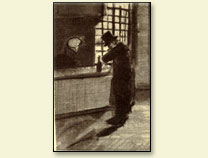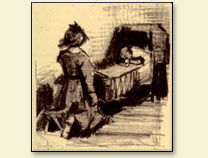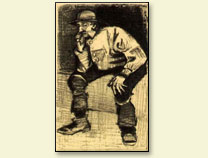|
Highlighting feelings - love - Turn off highlighting
The Hague, 21 -28 March 1883
My dear Theo,
You have so often afforded me a glimpse of Paris with your
descriptions, this time for a change I am giving you a glimpse
out of my window at the snow-covered yard.
I am adding a glimpse into a corner of the house, and they
are two impressions of one and the same winter's day.
We are surrounded by poetry on all sides, but putting it on
paper is, alas, not as readily done as looking at it.
I made a watercolour of the above, from which this small
sketch is taken, but I don't think it is vivid and powerful
enough.
To my mind the cold spell we had last week was the most
perfect part of this winter. It was fantastically beautiful,
what with the snow and the curious skies. The thawing of the
snow today was almost more beautiful still. But it was
typical winter weather, if I may call it that - the kind
of weather that awakens old memories and lends the most
ordinary things the sort of look one cannot help associating
with stories from the age of stagecoaches and post chaises.
Here, for example, is a quick little sketch I made in just
such a dream-like state. It shows a gentleman who, having
missed a coach or something of the sort, has had to spend the
night in a village inn. Now he has risen early, and having
ordered a glass of brandy against the cold, he is paying the
landlady (a little woman in a peasant's cap). It is still very
early in the morning, la piquette du jour [the crack of dawn],
- he must catch the post chaise - the moon is still shining and
one can see the snow glittering through the taproom window, and
all the objects are casting curious, whimsical shadows. This
story is really of no consequence, nor is the little sketch,
but one or another may perhaps help you to understand what I
mean, that is, that lately everything has a certain je ne sais
quoi, which makes one feel like getting it down quickly on
paper. Still, the whole of nature is an indescribably beautiful
Black and White exhibition during such snow effects.
As I am doing small sketches at present anyway, I am adding
another, very slight one, of a drawing done in mountain chalk,
the girl by the cradle, done like the woman
and child you mention. This mountain chalk is
truly the strangest material. The other little sketch of a
bargee is after a drawing in which a great deal has been lavis
[washed] with neutral tint and sepia.
It would not surprise me at all if the few things I sent you
recently seem to you rather meager products. Indeed I believe
it could hardly be otherwise. There is something inevitable
about the fact that, to appreciate the characteristic nature of
work in Black and White, one must take the whole set into
account all the time, which cannot always be done. What I mean
is that there is a difference between making 10 drawings and
making 100 drawings or sketches or studies. Not because of the
quantity, to be sure - forget about the quantity - what I am
trying to say is this, there is a kind of tolerance to Black
and White that enables one to draw a single figure one admires
in perhaps 10 different poses, while if one were to do it in,
say, watercolour, or to paint it, one would do just one
pose.
Now suppose 9 of those 10 are no good, and I hope in all
conscience that this would not be the proportion of good to bad
al the time, but just suppose that to be the case. If you were
here in the studio yourself, it is my belief that not a week
would pass without my being able to show you, not just one, but
a whole number of studies, and I should be surprised if
you were unable to pick out one from amongst that number that
appealed to you every time. Meanwhile the rest would not have
been done wholly in vain, since in some respects even
unsuccessful studies are likely to prove useful or serviceable
one day for some new composition.
And that is why I think that the next time you come, you may
well find a few more things about which you can give me a few
tips. For instance, it is quite hard, since I am not at all
familiar with Lhermitte's drawings (you will remember my asking
you about them), but am familiar with Ciceri's watercolours as
well as his old lithographic drawing examples, though not at
all with his current black and white drawings, I repeat, it's
quite hard for me to grasp your precise meaning when you write
with reference to a certain little sketch, “Couldn't you
do something that would somehow fit in with the above-mentioned
drawings?” I'm sure that both those artists are
infinitely more advanced than I - but your idea could be
feasible and I myself will keep learning too, don't you agree?
- so it's not beyond the bounds of possibility. And I wanted to
emphasize to you again that, in my opinion, supposing I do
produce something that would fit in, there is a sort of
tolerance to Black and White which would allow one to become
very productive in that direction, once one has embarked on it.
Not without working unremittingly, of course, but I do that
anyway.
So if the small drawings in mountain chalk I sent you are
not what you intended, although I had your tips in mind when I
did them, don't let that put you off and don't hesitate to
return to the subject, the more often the better. And bear in
mind, too, that as soon as I am sure of what you are after, I
shall be ready to do as I said just now, to turn out 10, for
example, in order to arrive at one good one. In short, if you
do come to the studio one day, I think you would see that I am
being fairly energetic, and you would, I hope, go on thinking
of me in these terms, wouldn't you, and you would understand as
well that even though someone who is fairly energetic may be
working hard for himself, or rather without an immediate
purpose, it might be twice as stimulating for him if there were
a purpose. This is also true of possible work for the
illustrated papers.
I immensely enjoyed rereading Fritz Reuter's Gedroogde
kruiden [Dried Herbs, the Dutch translation of Reuter's
Sämtliche Werke (Complete Works)] recently, it is just
like, say, Knaus or Vautier.
Do you know a draughtsman by the name of Régamey?
There is a lot of character in his work, I have got some
woodcuts, including drawings made in prison, and gypsies and
Japanese. When you come, you must have another look at the
woodcuts, I've acquired a few new ones since last time.
It may well seem to you that the sun is shining more
brightly and that everything has taken on a new charm. That, at
any rate, is the inevitable consequence of true love, I
believe, and it is a wonderful thing. And I also believe that
those who hold that no one thinks clearly when in love are
wrong, for it is at just that time that one thinks very clearly
indeed and is more energetic than one was before. And love is
something eternal, it may change in aspect but not in essence.
And there is the same difference between someone who is in love
and what he was like before as there is between a lamp that is
lit and one that is not. The lamp was there all the time and it
was a good lamp, but now it is giving light as well and that is
its true function. And one has more peace of mind about many
things and so is more likely to do better work.
How beautiful those old almshouses are, I can't find words
to describe them. And though Israëls does this sort of
thing to perfection, so to speak, I find it strange that so
relatively few should have an eye for it. Every day here
in The Hague, so to speak, I see a world which very many people
pass by and which is very different from what most make of it.
And I shouldn't dare to say so if I didn't know from experience
that figure painters, too, actually pass it by, and if I
didn't remember that whenever I was struck by some figure or
other I encountered while out walking with them, I would hear
time and again, “oh, those dirty people,” or
“that kind of person” - expressions, in short, one
would not expect from a painter.
Yes, that often used to make me think. I remember, for
instance, a conversation with Henkes, who frequently saw, and
sees, things so clearly, which took me completely by surprise.
It is as if they deliberately shun the most serious, the most
beautiful things, in short voluntarily muzzle themselves and
clip their own wings. And while I am gradually acquiring
greater respect for some, I cannot help thinking that others
will be reduced to sterility if they go on like that. And the
old Bohème was very insistent on this very point,
on being productive. And, and “La Bohème”
was no good, according to some, but mind you, there will always
be those who want to have their cake and eat it and, and, and
who will end up with jam on their faces. Snuff out the candle -
que soit [so be it] - but there is no point in applying the
snuffer prematurely. Goodbye, with a handshake,
 |
 |
Ever yours, Vincent
 |
Sketches “Early Morning Passenger” JH 339,
“Girl Kneeling at Cradle” JH 338, and
“Fisherman sitting with Pipe” F 1013, JH 345
enclosed with letter.
At this time, Vincent was 29 year oldSource:
Vincent van Gogh. Letter to Theo van Gogh. Written 21-28 March 1883 in The Hague. Translated by Mrs. Johanna van Gogh-Bonger, edited by Robert Harrison, number 276.
URL: https://www.webexhibits.org/vangogh/letter/12/276.htm.
This letter may be freely used, in accordance with the terms of this site.
|